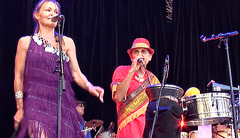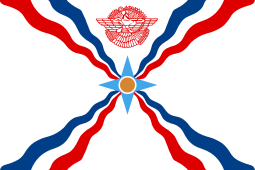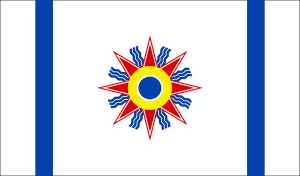Assyrian folk/pop music
Assyrian folk/pop music, also known as Assyrian folk music, Assyrian pop music or Syriac music (Syriac: ܡܘܣܝܩܝ ܣܦܝܢܘܬܐ ܐܬܘܪܝܬܐ/ܣܘܪܝܝܬܐ), is the traditional musical style of the Assyrian people that includes a broad range of stylistic varieties, which would also encompass fusions of Western genres such as pop, electronic, Latin, jazz and/or classical music, with a melodic basis of Assyrian folk.

Background
Assyrian folk music claims to be the descendant of the music of their ancient Upper Mesopotamian ancestors that has survived in the liturgical music of the Syriac Churches. Assyrian songs are generally sung in Iraqi Koine, a standard variety of Assyrian Neo-Aramaic. However, older songs mostly had an Urmian dialect and tribal-folk music tend to contain Tyari dialects. Themes tend to focus on longing, melancholy, strife and love issues. Assyrian songs are usually lengthy, tending to be around 5 minutes long on average.
Composition
Assyrian folk can also be found in traditional Middle Eastern makams, and it has similarities to other folk music in Western Asia, such as Kurdish, Turkish, Persian, and Armenian music. Unlike most Western music, Assyrian music includes quarter tones halfway between notes, often through the use of instruments or the human voice. Modern Assyrian pop music is mostly written in the minor key, and would typically use the Phrygian scale, as well as the harmonic minor scale as well.
Most recently, Assyrian dance music has a beat or rhythm similar to Jamaican music (see riddim). Solos are common in Assyrian music and they are usually protracted. Instrumentation is mostly arranged with a keyboard and electronic drums, namely in weddings or parties. Although many forms of Assyrian records do use acoustic and orchestral instruments such as strings, pianos, saxophones and violins.[1]
History
Folkloric period
Music is omnipresent in the village scene. A "musician" is not necessarily a professional, whoever can sing in any manner is considered a "singer". Most of the time, music is learned by ear and passed down as an oral tradition. Village music may be categorized, basically, into four groups: local secular music not related to specific occasions; functional music; religious music and hymns; music adopted from other areas.[2]
Here are a few types of tribal Assyrian Music that has survived to this day, especially in the Assyrian villages and towns of Northern Iraq, southeast Turkey, northwest Iran and northeast Syria:
- Raweh: An ancient melodic chant which features wailing echoed voices, usually of a male. Raweh is reminiscent of how one's voice echoes in a valley between mountains.
- Zurna O Dawolah: These are two traditional music instruments, literally meaning a drum and wind-pipe (or flute). They are played together, either with or without singing in many ceremonies such as weddings, welcoming and, albeit rarely, funerals.
- Diwaneh: Sung in gatherings and meetings; lyrics cover aspects of life such as, working in the fields, persecution, suffering, religion.
- Lilyana: Wedding songs usually sung by women only, especially for the bride before leaving her home to get married. Also sung for the bridegroom the day before his wedding by his family and relatives.
- Tanbur: Another tribal music instrument, a string instrument with long neck, originated in ancient Assyria, discovered being depicted on carving from South Iraq from Ur to Akkad and Ashur. Albert Rouel Tamraz was a famous Assyrian Singer from Iraq who played this instrument and sung many folkloric songs accompanied by hand-drum (tabla).
It was in the Assyrian homeland north of Mosul that people started to write the modern Syriac vernacular more than two hundred years before the earliest British missionaries, although the earliest records of the Syriac language date from 5th century BC Achaemenid Assyria. The earliest dated text is a poem written in 1591. This makes early Neo-Syriac literature a contemporary of Jewish Neo-Aramaic literature from roughly the same region, dating back to the late 16th century.
The Neo-Syriac literature which existed before the arrival of British and American missionaries consisted mainly of poetry. This poetry can be divided into three categories: stanzaic hymns, dispute poems, and drinking songs. Of these three categories, only the hymns, which in Neo-Syriac are termed duriky; and which can be seen as the equivalent of the Classical Syriac madrase, can usually be traced back to individual authors.[3]
Modern Assyrian Music
World War I, and the resulting Assyrian Genocide, drove many Assyrians out from the mountainous region of Hakkari, southeast Turkey to the regions of northern Iraq and north east Syria, and World War II brought them in direct contact with the west especially the British army in Iraq, Russians in Urmia and the French in Syria. But the contact with the British caused the most influence on modern Assyrian music, especially the period after the independence of Iraq in 1932, which brought British oil companies into Iraq and they employed many by now English speaking Assyrians. At this time they came in contact with Western music and instruments. Assyrian youth started picking up and playing these new instruments after seeing and hearing the British playing. Assyrian youths started to find new bands and to play in parties, picnics and other functions for both Assyrians and others.
Gabriel Asaad was the pioneer of Assyrian music and composed the first Assyrian song in the Turoyo language, Othuroye Ho Mtoth Elfan l-Metba‘ (1926, ܐܬܘܪܝܶܐ ܗܐ ܡܛܬ ܐܠܦܢ ܠܡܛܒܥ "Assyrians, Our ship is on the way to sink"). In Baghdad, Iraq the earliest known record is by Hanna Patros in 1931 – perhaps two Gramophones (78rpm) with 2 songs on each (church hymns and folk songs). Called “"Karuzuta d-khasha". Hanna Petros (1896–1958), later became the music director at the conservatory in Baghdad. There were church hymns and folklore songs with a musical company on the records. Albert Rouel Tamras releases his first records in Baghdad in 1966 on Bashirphone label owned by Jameil Bashir an Assyrian Iraqi oud and violin soloist. Singing in the background with Albert are Biba and Sargon Gabriel, two singers who would later become notable figures in modern Assyrian music in the US. Contemporaneously, Evin Agassi was also making music in Iran during the 1950s and 1960s.
From the 1970s and onward, Assyrian music started to incorporate elements from Western popular music, such as British and American music. Genres such as soft rock, pop ballads and dance pop became popular from 1980s and onward, although they all still had elements of Assyrian folk. In the 1990s and 2000s, Assyrian artists routinely fused in the traditional sounds of zurna and dawola conjured by electronic keyboards, as synthesized music got popular at that time. The Latin genre became popular in the late 1990s with instruments such as the Flamenco guitar being featured abundantly in Assyrian songs. Rock music never became popular in the Assyrian music scene, although a few Assyrian songs have featured electric guitars. Despite rock's unpopularity, there exists an Assyrian-Armenian metal band called Melechesh, which has extensive Assyrian-Mesopotamian influences both lyrically and instrumentally.[4]
It is customary for modern Assyrian artists to generally sing in Iraqi Koine, or "Standard Assyrian" (which is based on the prestigious Urmian dialect but has influences of the Hakkari dialects), for them to be intelligible and have widespread recognition. Songs in mountainous dialects, such as Tyari, are usually of the folk-dance music genre and would attract certain audiences.[5] Due to Arab influence, some Assyrian singers may incorporate mawwal in their music.
Samples
Although Assyrian music generally have a similar chord progression and are usually in the minor key, the genre and instrumentation of the music vastly differ from each other, as evident in these samples:
Assyrian dances
Some of the notable Assyrian dances include:
- Khigga: Which is a circle dance and is one of the most commonly danced, maybe because it is very simple to dance and also it is the first beat that is played in welcoming the Bride and Groom to the reception Halls, at least in the East Assyrian tradition. Some of these, dancing such as Khigga also have other sub-styles like 'heavy khigga' or 'normal khigga'. Heavy simply means the same dance beat but slower. Another style and interesting move with Khigga is instead of taking steps forward they would actually step back, so they would be dancing but will be moving back, "khigga d'suria" (Khigga of Syria), found among Assyrians of Syria.
- Shekhani: It describes the scene depicting the commander of the army returning from a war. Ashur, the second in command has spoken to the army about the victory of their commander. He has given them good tidings, thus the armed forces world then start dancing Shekhani, which then start a well esteemed dance by the Assyrian. Some say the word comes from Bshkhana (getting warm), Assyrians before going on a hunt or battle they would dance on this beat to get warm. Much of the Assyrian original homeland was in snow-peaked mountains of Ashur, Assyria.
- Gubare: Energetic, lively dance that has a fast dance beat. Common at the end of a party or wedding.
- The Sword and Shield dance: A man would hold a sword and, at times, a shield, and dance around with it in stylistic manner. He would be usually wearing Assyrian clothing.
List of Assyrian singers
- Janan Sawa (1956-) Assyrian singer from Iraq based in America
- Faia Younan (1992-) Assyrian singer from Syria based in Sweden
- Robert Ibrahimi (1949-) Assyrian singer from Iran based in Arizona
- Roben Talow Assyrian singer from Iraq based in Toronto
- Shamiram Urshan (1938–2011) Assyrian singer and entertainer from Iran based in California
- Albert Ruel Tamras (1944 - 2011-07-24) Assyrian singer/songwriter from Iraq based in Arizona
- Acrassicauda, USA-based Iraqi thrash-metal band formed in 2001
- Evin Agassi (1945-)
- Gabriel Asaad (1907-97)
- Ashur Bet Sargis (1949-)
- Elbra Amanda Mansur (1991-)
- Assur Kings Entertainment, Sydney based Assyrian drumming and entertainment group
- Rola Bahnam - Lebanon-based TV-presenter and singer with The 4 Cats
- Jamil Bashir (1920-77)
- Munir Bashir (1930-97)
- King Biba (Edward Yousif, 1945-95)
- Aril Brikha (1976-) - Assyrian Techno/House music artist
- George Chaharbakhshi (1952-)
- Sargon Gabriel (1947-)
- Linda George (1964-)
- Claudia Hanna - Assyrian singer of Arabic & Assyrian music, based in Egypt
- Nouri Iskandar (1938-)
- Elias Karam (1960-)
- Paulus Khofri (1923-2000)
- Melechesh - Assyrian/Armenian black-metal/Mizrahi metal band, formed 1993 in Jerusalem, currently in Amsterdam
- Adwar Mousa (1950-)
- Lida Lawando (1954-)
- abeer Nehme (1980-)
- Josef Özer (1983-)
- Hanna Patros (1896-1958), in the 1930s and 1940s
- Ninsun Poli (active 2004-)
- Nawfal Shamoun (1968-)
- Timz (real name Tommy Hanna, born 1985) Assyrian American Rap musician
- Marganita Vogt-Khofri (1952-)
- Elias Zazi (1964-)
See also
- Turkish pop music
- Iranian pop music
- Kurdish music
- Arab pop music
- Assyrian folk dance
References
- Subhi Anwar Rashid, The History of Musical Instruments in Old Iraq. Pg 180-181
- Journalism: A 140-Year Experience”, Journal of the Assyrian Academic Society, Vol. VII, No. 2, 1993. pp. 17-8
- H. L. Murre-van den Berg
- Rimmer, J. Ancient musical Instruments of western Asia in the British Museum, London 1969 p. 39.f.pl.21, 17,18,199
- Solomon, Zomaya S. (1997). Functional and other exotic sentences in Assyrian Aramaic, Journal of Assyrian Academic Studies, Xi/2:44-69.
External links
- History of the Syriac Folk music, Syriacmusic.com



